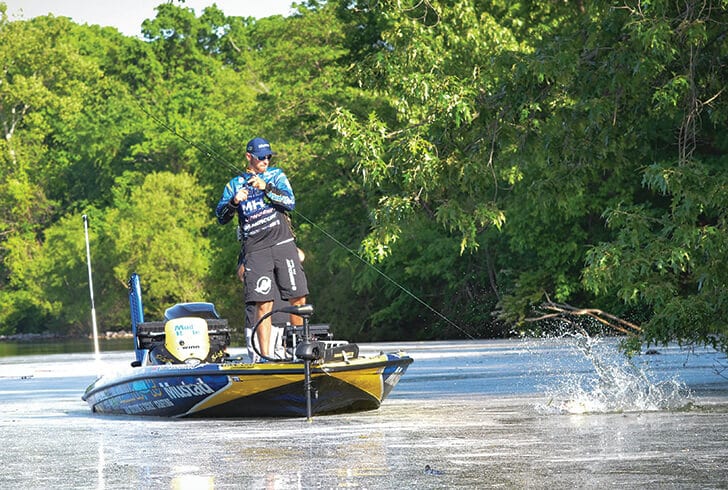Bass get away for two reasons: the hook coming out of their mouth or line failure. If you can keep those from happening, you’ll land the fish. Sounds simple right? Well, it is and it isn’t. But having the right combination of hook, line and rod—and using them all properly—will lead to fewer lost fish.
The hookset is predominately a factor of the right hook paired with the right fishing rod. You generally want to use the biggest, sturdiest hook and the heaviest power rod that the particular technique and lure will allow. And you’ve got to set the hook as hard as your equipment will allow. Watch the hooksets of pro anglers on the Bassmasters television show. We do not mess around when it comes to setting the hook.
The biggest challenge with matching hook and rod power is learning how big you can go while still presenting the bait properly. You’ll get more bites using smaller hooks and lighter line, so you can’t always use the heaviest equipment. Pay close attention to the bait and lure weights your rod is rated for. I build all my rods with blanks and supplies from Mud Hole Custom Tackle (www.MudHole.com). Their blanks come with that information included. Winn Grips are a must on all my rods as they ensure a proper grip on the rod for that big hookset.
A good quality hook is one that penetrates a fish’s mouth and stays there. Obviously, the sharper the hook, the better. Once set, the hook has to be strong enough to not “flex” or open up. A flexing hook takes pressure off the bass and can allow him to pull off. Packaged baits often come with cheap hooks that will flex even on the first fish. Lesser-quality hooks become dull faster too. I trust Mustad, and no other hooks are in my boat.
Slack in the line is another way for the hook to come out of the fish’s mouth. When you hook a fish, sometimes it will make a hard run at the boat, creating slack. This can allow the hook to wiggle free. A high-speed reel and quick recognition that the fish is swimming toward you are keys to keeping slack out of the line. Having a longer rod helps you keep the line tight, and you can also keep the line tight by walking backward.
In addition to the potential for line breakage, fish getting into and around cover can cause slack in the line. Once a fish turns its head with the line tight against cover, there’s serious potential for slack to form. When fishing around cover, it is important to get the fish into open water and toward the boat quickly. That’s another plus to a powerful hookset, which will get that fish moving in the right direction.
My final tip is to learn from your mistakes, and the best way to learn is by fishing as much as possible. The more you fish, the better you’ll get at putting fish in the boat.
